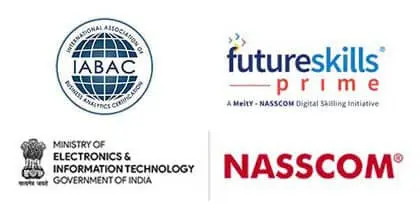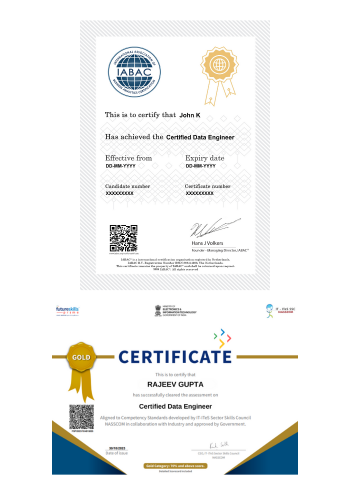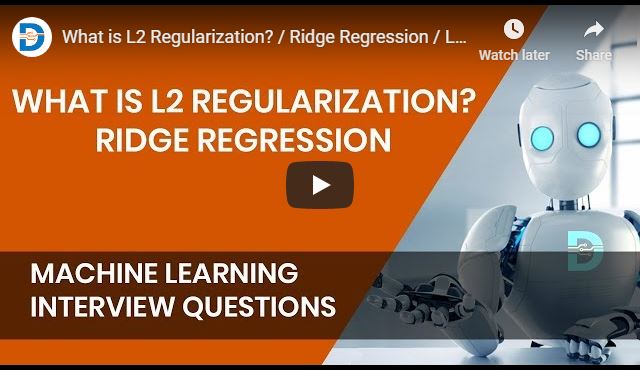Instructor Led Live Online
Self Learning + Live Mentoring
In - Person Classroom Training
The entire training includes real-world projects and highly valuable case studies.
IABAC® certification provides global recognition of the relevant skills, thereby opening opportunities across the world.
MODULE 1: DATA ENGINEERING INTRODUCTION
• What is Data Engineering?
• Data Engineering scope
• Data Ecosystem, Tools and platforms
• Core concepts of Data engineering
MODULE 2: DATA SOURCES AND DATA IMPORT
• Types of data sources
• Databases: SQL and Document DBs
• Managing Big data
MODULE 3: DATA INTEGRITY AND PRIVACY
• Data integrity basics
• Various aspects of data privacy
• Various data privacy frameworks and standards
• Industry related norms in data integrity and privacy: data engineering perspective
MODULE 4: DATA ENGINEERING ROLE
• Who is a data engineer?
• Various roles of data engineer
• Skills required for data engineering
• Data Engineer Collaboration with Data Scientist and other roles.
MODULE 1: PYTHON BASICS
• Introduction of python
• Installation of Python and IDE
• Python objects
• Python basic data types
• String functions part
• String functions part
• Python Operators
MODULE 2: PYTHON CONTROL STATEMENTS
• IF Conditional statement, IF-ELSE
• NESTED IF
• Python Loops Basics, WHILE Statement
• BREAK and CONTINUE statements
• FOR statements
MODULE 3: PYTHON PACKAGES
• Introduction to Packages in Python
• Datetime Package and Methods
MODULE 4: PYTHON DATA STRUCTURES
• Basic Data Structures in Python
• Basics of List
• List methods
• Tuple: Object and methods
• Sets: Object and methods
• Dictionary: Object and methods
MODULE 5: PYTHON FUNCTIONS
• Functions basics
• Function Parameter passing
• Lambda functions
• Map, reduce, filter functions
MODULE 1 : OVERVIEW OF STATISTICS
• Introduction to Statistics: Descriptive And Inferential Statistics
• a.Descriptive Statistics
• b.Inferential Statistis
• Basic Terms Of Statistics
• Types Of Data
MODULE 2 : HARNESSING DATA
• Random Sampling
• Sampling With Replacement And Without Replacement
• Cochran's Minimum Sample Size
• Types of Sampling
• Simple Random Sampling
• Stratified Random Sampling
• Cluster Random Sampling
• Systematic Random Sampling
• Multistage Sampling
• Sampling Error
• Methods Of Collecting Data
MODULE 3 : EXPLORATORY DATA ANALYSIS
• Exploratory Data Analysis Introduction
• Measures Of Central Tendencies, Measure of Spread
• Data Distribution Plot: Histogram
• Normal Distribution
• Z Value / Standard Value
• Empherical Rule and Outliers
• Central Limit Theorem
• Normality Testing
• Skewness & Kurtosis
• Measures Of Distance: Euclidean, Manhattan And Minkowski Distance
• Covariance and Correlation
MODULE 4 : HYPOTHESIS TESTING
• Hypothesis Testing Introduction
• Types of Hypothesis
• P- Value, Crtical Region
• Types of Hypothesis Testing: Parametric, Non-Parametric
• Hypothesis Testing Errors : Type I And Type II
• Two Sample Independent T-test
• Two Sample Relation T-test
• One Way Anova Test
• Application of Hypothesis Testing (Proposed)
MODULE 1: DATA WAREHOUSE FOUNDATION
• Data Warehouse Introduction
• Database vs Data Warehouse
• Data Warehouse Architecture
• Data Lake house
• ETL (Extract, Transform, and Load)
• ETL vs ELT
• Star Schema and Snowflake Schema
• Data Mart Concepts
• Data Warehouse vs Data Mart —Know the Difference
• Data Lake Introduction architecture
• Data Warehouse vs Data Lake
MODULE 2: DATA PROCESSING
• Python NumPy Package Introduction
• Array data structure, Operations
• Python Pandas package introduction
• Data structures: Series and DataFrame
• Importing data into Pandas DataFrame
• Data processing with Pandas
MODULE 3: DOCKER AND KUBERNETES FOUNDATION
• Docker Introduction
• Docker Vs.VM
• Hands-on: Running our first container
• Common commands (Running, editing,stopping,copying and managing images)YAML(Basics)
• Publishing containers to DockerHub
• Kubernetes Orchestration of Containers
• Docker swarm vs kubernetes
MODULE 4: DATA ORCHESTRATION WITH APACHE AIRFLOW
• Data Orchestration Overview
• Apache Airflow Introduction
• Airflow Architecture
• Setting up Airflow
• TAG and DAG
• Creating Airflow Workflow
• Airflow Modular Structure
• Executing Airflow
MODULE 5: DATA ENGINEERING PROJECT
• Setting Project Environment
• Data pipeline setup
• Hands-on: build scalable data pipelines
MODULE 1 : AWS DATA SERVICES INTRODUCTION
• AWS Overview and Account Setup
• AWS IAM Users, Roles and Policies
• AWS S overview
• AWS EC overview
• AWS Lamdba overview
• AWS Glue overview
• AWS Kinesis overview
• AWS Dynamodb overview
• AWS Athena overview
• AWS Redshift overview
MODULE 2 : DATA PIPELINE WITH GLUE
• AWS Glue Crawler and setup
• ETL with AWS Glue
• Data Ingesting with AWS Glue
MODULE 3 : DATA PIPELINE WITH AWS KINESIS
• AWS Kinesis overview and setup
• Data Streams with AWS Kinesis
• Data Ingesting from AWS S using AWS Kinesis
MODULE 4 : DATA WAREHOUSE WITH AWS REDSHIFT
• AWS Redshift Overview
• Analyze data using AWS Redshift from warehouses, data lakes and operations DBs
• Develop Applications using AWS Redshift cluster
• AWS Redshift federated Queries and Spectrum
MODULE 5 : DATA PIPELINE WITH AZURE SYNAPSE
• Azure Synapse setup
• Understanding Data control flow with ADF
• Data Pipelines with Azure Synapse
• Prepare and transform data with Azure Synapse Analytics
MODULE 6 : STORAGE IN AZURE
• Create Azure storage account
• Connect App to Azure Storage
• Azure Blob Storage
MODULE 7: AZURE DATA FACTORY
• Azure Data Factory Introduction
• Data transformation with Data Factory
• Data Wrangling with Data Factory
MODULE 8 : AZURE DATABRICKS
• Azure databricks introduction
• Azure databricks architecture
• Data Transformation with databricks
MODULE 9 : AZURE RDS
• Creating a Relational Database
• Querying in and out of Relational Database
• ETL from RDS to databricks
MODULE 10 : AZURE RDS
• Hands-on Project Case-study
• Setup Project Development Env
• Organization of Data Sources
• AZURE/AWS services for Data Ingestion
• Data Extraction Transformation
MODULE 1: GIT INTRODUCTION
• Purpose of Version Control
• Popular Version control tools
• Git Distribution Version Control
• Terminologies
• Git Workflow
• Git Architecture
MODULE 2: GIT REPOSITORY and GitHub
• Git Repo Introduction
• Create New Repo with Init command
• Copying existing repo
• Git user and remote node
• Git Status and rebase
• Review Repo History
• GitHub Cloud Remote Repo
MODULE 3: COMMITS, PULL, FETCH AND PUSH
• Code commits
• Pull, Fetch and conflicts resolution
• Pushing to Remote Repo
MODULE 4: TAGGING, BRANCHING AND MERGING
• Organize code with branches
• Checkout branch
• Merge branches
MODULE 5: UNDOING CHANGES
• Editing Commits
• Commit command Amend flag
• Git reset and revert
MODULE 6: GIT WITH GITHUB AND BITBUCKET
• Creating GitHub Account
• Local and Remote Repo
• Collaborating with other developers
MODULE 1 : DATABASE INTRODUCTION
MODULE 2 : SQL BASICS
MODULE 3 : DATA TYPES AND CONSTRAINTS
MODULE 4 : DATABASES AND TABLES (MySQL)
MODULE 5 : SQL JOINS
MODULE 6 : SQL COMMANDS AND CLAUSES
MODULE 7 : DOCUMENT DB/NO-SQL DB
MODULE 1: BIG DATA INTRODUCTION
• Big Data Overview
• Five Vs of Big Data
• What is Big Data and Hadoop
• Introduction to Hadoop
• Components of Hadoop Ecosystem
• Big Data Analytics Introduction
MODULE 2: HDFS AND MAP REDUCE
• HDFS – Big Data Storage
• Distributed Processing with Map Reduce
• Key Terms: Output Format
• Partitioners Combiners Shuffle and Sort
• Hands-on Map Reduce task
MODULE 3: PYSPARK FOUNDATION
• PySpark Introduction
• Resilient distributed datasets (RDD),Working with RDDs in PySpark, Spark Context , Aggregating Data with Pair RDDs
• Spark Databricks
• Spark Streaming
MODULE 1: SPARK SQL and HADOOP HIVE
• Introducing Spark SQL
• Spark SQL vs Hadoop Hive
• Working with Spark SQL Query Language
MODULE 2: KAFKA and Spark
• Kafka architecture
• Kafka workflow
• Configuring Kafka cluster
• Operations
MODULE 3: KAFKA and Spark
• Creating an HDFS cluster with containers
• Creating pyspark cluster with containers
• Processing data on hdfs cluster with pyspark cluster
MODULE 1: TABLEAU FUNDAMENTALS
• Introduction to Business Intelligence & Introduction to Tableau
• Interface Tour, Data visualization: Pie chart, Column chart, Bar chart.
• Bar chart, Tree Map, Line Chart
• Area chart, Combination Charts, Map
• Dashboards creation, Quick Filters
• Create Table Calculations
• Create Calculated Fields
• Create Custom Hierarchies
MODULE 2: POWER-BI Basics
• Power BI Introduction
• Basics Visualizations
• Dashboard Creation
• Basic Data Cleaning
• Basic DAX FUNCTION
MODULE 3: DATA TRANSFORMATION TECHNIQUES
• Exploring Query Editor
• Data Cleansing and Manipulation:
• Creating Our Initial Project File
• Connecting to Our Data Source
• Editing Rows
• Changing Data Types
• Replacing Values
MODULE 4: CONNECTING TO VARIOUS SOURCES
• Connecting to a CSV File
• Connecting to a Webpage
• Extracting Characters
• Splitting and Merging Columns
• Creating Conditional Columns
• Creating Columns from Examples
• Create Data Model
Data engineering encompasses the utilization of engineering principles and methods to manage the complete data lifecycle, covering activities such as data collection, ingestion, storage, processing, integration, and delivery. Its primary emphasis is on achieving scalability, reliability, and efficiency.
To pursue a career as a data engineer in Agra, individuals can follow these steps:
a. Obtain a degree in computer science, engineering, or a related field.
b. Develop proficiency in programming languages such as Python, SQL, or Java.
c. Gain knowledge of database management systems and data processing frameworks like Hadoop and Spark.
d. Acquire practical experience through internships, projects, or working on data-related tasks.
e. Continuously update skills by staying informed about emerging technologies and industry trends.
It is indeed feasible to transition from a mechanical background to data engineering. While having a computer science or related field background can facilitate the process, individuals can bridge the gap by acquiring essential skills like programming, database management, and data processing. Consider exploring training programs or obtaining certifications in data engineering to further enhance your prospects.
Emerging advancements and shifts in data engineering include the rise of cloud-based solutions, such as AWS and Azure, for scalable and flexible data management. Big data processing frameworks like Apache Spark and Hadoop are becoming more prevalent. Real-time data streaming with technologies like Apache Kafka and Flink is gaining importance. Integration of DataOps and DevOps methodologies is becoming widespread, promoting agility in data management. Additionally, machine learning and AI are being incorporated into data engineering workflows for enhanced data processing and analysis capabilities.
The future prospects for individuals building a career as data engineers are highly promising. With the ever-growing volume and complexity of data being generated, organizations are seeking skilled professionals who can effectively manage, process, and analyze data. The rapid advancements in technology, coupled with the increasing importance of data-driven insights, create a favorable landscape for data engineers. By continually upgrading their skills and staying abreast of emerging technologies, data engineers can expect ample career opportunities and professional growth.
The training fees for data engineer programs in Agra can differ based on factors like the training institute, course duration, and mode of training (online or classroom). Generally, the cost can range between 40,000 INR to INR 1,00,000. To get accurate information, it's advisable to explore various training providers in Agra and inquire about the specific costs associated with their data engineer training courses.
Considered among the top providers of Data Engineer Training, DataMites stands out due to its well-designed curriculum, practical projects aligned with industry needs, and knowledgeable trainers. DataMites has a proven track record of delivering high-quality education that prepares individuals to excel in the dynamic field of data engineering.
Upon completion of Data Engineer Training in Agra, individuals can expect promising job prospects. They can pursue careers as Data Engineers, Data Analysts, Data Scientists, Database Administrators, or Business Intelligence Developers.
Fundamental skills for success as a data engineer include proficiency in programming languages like Python or Java, expertise in database management (SQL, NoSQL), familiarity with big data processing frameworks (Hadoop, Spark), strong grasp of data integration and ETL processes, and the ability to design and optimize data architectures.
The average salary range for Data Engineers in Agra can vary depending on factors such as experience, skills, industry, and the organization's size. Generally, the average salary range for Data Engineers in Agra falls between INR 3,00,000 to INR 8,00,000 per annum.
DataMites offers training programs designed to meet industry demands, featuring experienced instructors, practical projects, and hands-on learning opportunities. By enrolling in these programs, individuals can acquire the skills and knowledge essential for excelling in the field of data engineering.
The curriculum of the DataMites Certified Data Engineer Training program in Agra includes specific topics such as data engineering fundamentals, database management, data warehousing, ETL processes, big data processing frameworks, data visualization, and advanced analytics techniques.
The length of the DataMites Data Engineer Course in Agra is flexible and depends on the learning mode selected. Generally, online instructor-led training lasts for approximately 6 months, involving over 150 learning hours. Keep in mind that the duration may differ for self-paced learning alternatives.
DataMites offers Data Engineer Training in Agra at prices that can fluctuate based on factors like the specific program chosen, training mode (online or classroom), and any added resources or features. The fees for the data engineer course at DataMites in Agra typically span from approximately INR 26,548 to INR 68,000, depending on the program and any supplementary components incorporated.
DataMites' Flexi-Pass provides learners with the advantage of attending multiple batches of the same course within a designated period. This enables learners to strengthen their grasp of the course content, revisit important concepts, and solidify their understanding of the subject matter, thereby enhancing their overall learning experience.
Generally, eligibility for the Data Engineer Course at DataMites in Agra requires an educational background in computer science, engineering, mathematics, or a related field.
Yes, upon successfully completing Data Engineer training at DataMites, participants will be granted certifications. DataMites has partnerships with prestigious organizations like the International Association of Business Analytics Certifications (IABAC), NASSCOM FutureSkills Prime, and Jain (Deemed-to-be University). These collaborations ensure that the training programs meet industry requirements and offer certifications that hold value.
If a participant misses a session during Data Engineer training at DataMites, they generally have access to recorded sessions or can attend makeup sessions at a later time. DataMites' objective is to ensure that learners have the means to make up for missed content and progress effectively in their learning journey.
Yes, DataMites typically provides the option to attend a demo class prior to making the course fee payment. This allows individuals to gauge the teaching methodology, interact with instructors, and have a preview of the course content and structure. Participating in a demo class assists in making an educated decision about enrolling in the training program.
DataMites provides both classroom and online training options for Data Engineer courses in Agra. Participants have the flexibility to choose the training mode that suits their needs and preferences. Regardless of the chosen mode, DataMites delivers comprehensive instruction and hands-on learning experiences to foster proficiency in data engineering skills.
The DataMites Placement Assistance Team(PAT) facilitates the aspirants in taking all the necessary steps in starting their career in Data Science. Some of the services provided by PAT are: -
The DataMites Placement Assistance Team(PAT) conducts sessions on career mentoring for the aspirants with a view of helping them realize the purpose they have to serve when they step into the corporate world. The students are guided by industry experts about the various possibilities in the Data Science career, this will help the aspirants to draw a clear picture of the career options available. Also, they will be made knowledgeable about the various obstacles they are likely to face as a fresher in the field, and how they can tackle.
No, PAT does not promise a job, but it helps the aspirants to build the required potential needed in landing a career. The aspirants can capitalize on the acquired skills, in the long run, to a successful career in Data Science.











